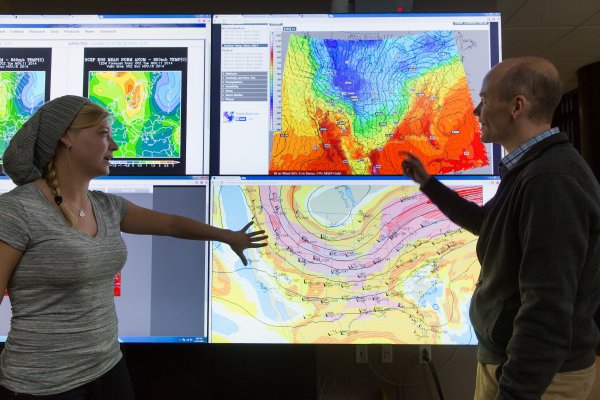Department History
In 1926, when the Lutheran administration was established at Valparaiso University, the only geography courses were Physiography and General Geology. Alfred H. Meyer was the instructor of both these courses as well as Zoology. By 1927, several courses were added: Geography of North America, Engineering Geology, Crystallography, and Economic Geography. In the 1929-1930 academic year, enrollments totaled 189.
The Department of Geography and Geology was initiated in 1931. Curriculum changes indicated the beginning of a shift in emphasis from physical to human geography. New courses included World Geography, Geography of Europe, World Problems, and Field Geography. Between 1931 and 1941, student enrollment ranged from 71 to 402. By 1945, the growth of the department necessitated staff additions, and one new instructor was added in each of the 1945, 1949, 1950, and 1957 academic years. Fifteen new courses were taught between 1941 and 1951, with the shift to cultural emphasis again apparent as these included Political Geography, Maps and Man, Geographic Planning, Philosophy and Profession of Geography, and one rather unusual-sounding course entitled Geology and Genesis. Enrollments during this period ranged from 285 to 1,321. By 1961, the staff numbered seven and enrollments reached 1,385.
In 1963, graduate credit became possible in geography, as the University offered a master of liberal studies. Historical Geography of the U.S., Geography of World Affairs, and Area Field Studies became 200-level courses offered for graduate or undergraduate credit. Straight graduate credit was given for the 300-numbered courses: Geographic Thought, Western Cultural Geography, and American Resources. The staff continued to grow, then numbering nine, with total enrollments near 1,800.
The success of the department at this time can be inferred at least in part by the large percentage of students who went on to attain advanced degrees. As many as 60 percent of students went on to graduate school at this time. Much of this record can be attributed to Professor Meyer, who had been with the University since 1926 and was head or chair of the department throughout much of its history. Recognizing his impact in the geographical community, the National Council for Geographic Education named him the recipient of its Distinguished Service Award in 1969, noting:
This undergraduate department has not only helped educate thousands of geography, social science, and physical science teachers for both the elementary and secondary schools, but has provided majors with such superior subject-matter backgrounds and teaching know-how that this private church-related college has had more of its graduates take advanced degrees in geography than any other undergraduate college in Indiana, the Midwest, and perhaps the United States.
Following Professor Meyer’s retirement in 1975, Professor Ferencz P. Kallay assumed the chairmanship. In the following years, the department and its students enjoyed additional success. The stream of students to graduate schools — usually with grants, fellowships, and assistantships in hand — continued. Professor Kallay was succeeded by Professor Alice Rechlin and then Professor Richard Hansis as chair, taking the department through most of the 1980s. In 1987, Professor Ronald Janke became chair, serving in that role through the 1990s. Professor Jon T. Kilpinen became chair in 2000 and held that post until 2006 when he became dean of the College of Arts and Sciences. Professor Bart Wolf followed Professor Kilpinen, and Professor Teresa M. Bals-Elsholz currently serves as chair of the department.
The 1990s were a period of much change in the department. In 1991, the University approved the establishment of a separate major in meteorology, replacing the concentration in meteorology for geography majors. The department was also renamed the Department of Geography and Meteorology. Two degreed meteorologists joined the faculty, complementing the three geographers. The department also moved out of its long-time home in Kroencke Hall, relocating to the lower story of Mueller Hall just prior to the beginning of the 1997-1998 academic year. There, faculty offices joined the expanded weather center and the laboratory classroom.
Today the department continues to prosper and grow. On April 30, 2005, Kallay-Christopher Hall, the new home of the geography and meteorology department, was dedicated. In the fall of 2006, a Doppler radar was installed on campus, a new bachelor of science major in geoscience was developed, and a fourth meteorology professor was added. The geoscience major was refined a few years later into the bachelor of science in geography. A bachelor of arts in geography education for future social science teachers has been our most recent addition.
In the new millennium, enrollment in the department has leveled to about 120 students. In geography, with three geography faculty approximately 45 students either major or minor each year. With five meteorology faculty members and a staff meteorologist, enrollment numbers around 100 meteorology majors make for ideal class sizes and allow for close interaction between students and faculty. These class sizes also permit frequent field study opportunities both regionally and nationally; geography conducts a number of field studies, investigating the Peaks and Pueblos of the Desert Southwest, landmarks of the Oregon Trail and Yellowstone National Park, and Grand Canyon, Hawaiian lava flows, and many other national parks. Similarly, meteorology annually conducts one to two convective field studies to the Great Plains in May and June.
